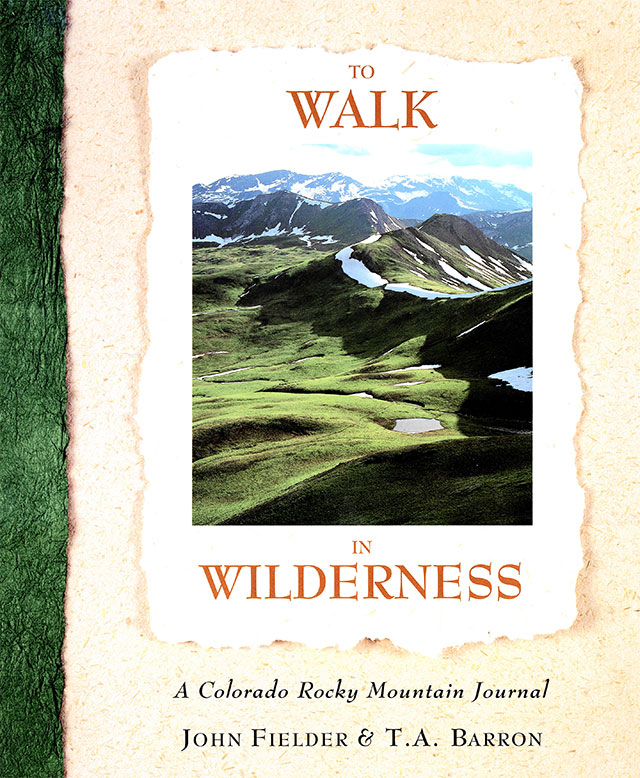
TO WALK IN WILDERNESS EXCERPT

From Day 3
Rain, relentless rain. The downpour at Little Gem Lake continues unabated all through the night and well into the next day. At times fog rolls in, so thick that the ground a few feet outside our sopping tent becomes nothing more than a cloud. The rain turns to sleet, then to snow, and I watch the wide flakes settle by the thousands on the surface of the lake. The turf outside turns white as the air grows colder. Rockslides fall every few hours, the only sound outside of the swirling storm.
Trying in vain to warm my hands, I wonder: What drives otherwise sensible people to seek out experiences like this? Is there a mad streak in humanity, a perverse desire to shiver in wet sleeping bags?
Maybe we put up with the painful sides of wilderness because its pleasureful sides are so wondrously potent. Maybe all the remarkable convenience, speed and data transmission of our age still leaves us hungering for some of the basic truths and reliable rhythms of nature—so that we willingly give up comfort for the body to find comfort for the soul. I doubt it is accidental that prophets from all cultures have traditionally plunged into wilderness for a time. Wild places, and wild storms, provoke us to clarify and simplify, to distill our abundant cleverness into a few drops of wisdom.
From Day 8
Mist rises off the floor of Conundrum Creek valley, curling slowly skyward. As we follow the creek in the gentle rain, often walking in fog, we seem to be trekking through a damp rain forest. Leaves drip everywhere, lively rivulets bounce down the banks to join the creek, lupines collect glittering pearls of water within their palmate leaves.
About three miles from the trailhead, tan-colored cliffs rise from both sides of the creek. They exemplify the complex geology of this region, where rocks of widely varied ages and origins are mixed together like ingredients in a great pot of Thanksgiving stew.
Small wonder, then, that the cliffs before us have their own story to tell, one with a modern twist. In the midst of their granite faces are intrusions of marble — just as in the midst of this wilderness are the intrusions of mining claims. As we approach an infrequently worked marble mine, stepping over rusting scraps of metal, cable, bolts and machinery, it is not difficult to imagine the impact of an active mining operation on this place. Yet because of exemptions in the Wilderness Act of 1964, that is a genuine possibility. If it happens, the whisper and hush of water and leaf would give way to the screech and clatter of hammer and generator.
Wind and hail whipping our faces, we finally reach the pass at nearly 13,000 feet, a full 4,000 feet higher than our starting point this morning. We secure the llamas and set up our tents on the trail itself — the only flat place around — all the while trying to keep our gear and ourselves from blowing off the mountain.
At last, the storm subsides. The full moon, glowing like a luminous lamp, rises over a bank of pink clouds. Our world is washed in silver. We dine on a jumble of ice-crusted rocks. Our simple menu of dried fruit and granola bars turns into a grand repast because of one addition: silence. For the entire meal, none of us speaks a word. Like animals who have not forgotten how to sit quietly together, we listen to the stream, to the ridge, to the stillness of the lichened rocks.
From Day 25
From our perch on top of the pass, it is easy to follow the sun’s advance over land and sky. I turn back and forth from the sweeping pastels in the east to the deepening line of pink above the blue Earth shadow in the west. Clouds metamorphose in color, while the mountains follow, one radiant step behind. The luminous procession continues, moving over one ridge the next, one summit then another, until at last the entire world as far as we can see is bathed in new morning light. The breeze blows crisply, tousling our sleeping bags. Dawn.
Passing through a long alleyway of bluebells, we drop over East Avalanche Pass. Stark towers of stone, etched against the rich blue sky, line the ridge. Westward we can see dozens of drainages, contorted and wild, as rugged as any in the Brooks Range of Alaska. Substantial fields of snow cling to the shadowed bowls, while tufts of green grass pepper the slopes. Behind us rises a new side of Snowmass Mountain, its sharp ridge sheltering the hidden cirque we know to hold the Pierre Lakes. Enormous quantities of red paintbrush, blue lupine and yellow cinquefoil make the meadow under our feet ripple with vibrant colors.
This is a day to go on forever. As we stride along the ridge, we hear the continuous rising and falling of wind in the passes, mountain streams in the valleys, birds in the cloudless sky, shifting rocks in the ravines, all combining in a single sonorous fugue. As the ridge stretches before me, so it seems does life, full of hope and opportunity and challenge. I am ready to face anything. Even as the late afternoon light deepens the hues and shadows, signaling the inevitable approach of night, I feel far more joy at having lived this day than grief at having lost it.
By a tarn surrounded with marsh marigolds, we make camp. Sunset comes slowly and intensely, reflected on the craggy spires of Meadow Mountain and the neighboring peaks. When I awoke before dawn, my sleeping bag is coated with frost, as if the stars have descended during the night and lodged there, sparkling for a while.
